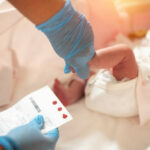Neonatal hypoglycemia occurs when a newborn’s blood sugar (glucose) levels drop below 47 mg/dL (2.6 mmol/L) after birth. Since glucose is the main source of energy for the brain and body, low blood sugar can lead to serious complications, including seizures, brain damage, and developmental delays, if not treated promptly.
📌 Fact: Babies of diabetic mothers (gestational, type 1, or type 2) have a much higher risk of neonatal hypoglycemia due to excessive insulin production.

🩺 Why Are Babies of Diabetic Mothers at Higher Risk?
During pregnancy, a mother’s blood sugar crosses the placenta, providing glucose to the baby. If the mother has high blood sugar levels (hyperglycemia) due to diabetes, the baby’s pancreas responds by producing extra insulin to manage the excess glucose.
After birth:
🔸 The maternal glucose supply suddenly stops when the umbilical cord is cut.
🔸 The baby’s body continues to produce high levels of insulin, which rapidly lowers blood sugar.
🔸 This overcorrection can lead to severe hypoglycemia, requiring immediate medical intervention.
📌 Fact: Neonatal hypoglycemia occurs in up to 50% of babies born to mothers with diabetes.
⚠️ What Are the Symptoms of Neonatal Hypoglycemia?
Many newborns with low blood sugar may show no obvious symptoms, so routine blood sugar monitoring is critical. However, in more severe cases, symptoms may include:
❌ Jitteriness or tremors
❌ Weak or high-pitched cry
❌ Poor feeding or refusal to eat
❌ Lethargy or difficulty waking up
❌ Seizures (in severe cases)
📌 Fact: Since neonatal hypoglycemia can be “silent,” babies of diabetic mothers are closely monitored for the first 24-48 hours after birth.
📌 Final Thoughts
Neonatal hypoglycemia is especially common in babies of diabetic mothers due to excess insulin production during pregnancy. Early detection and treatment are crucial to preventing serious complications.







